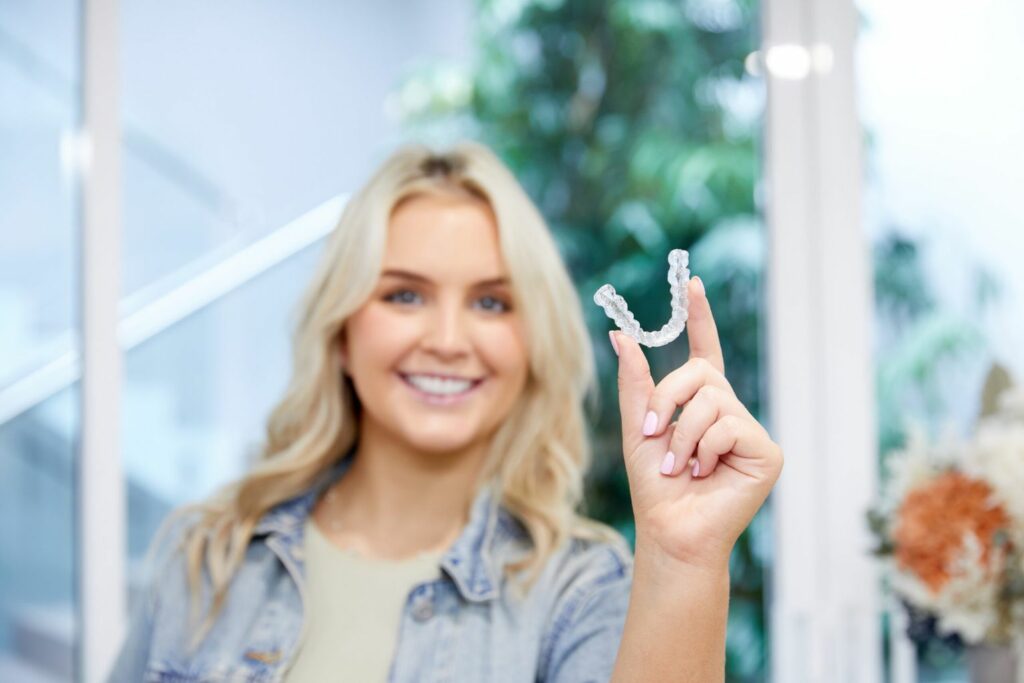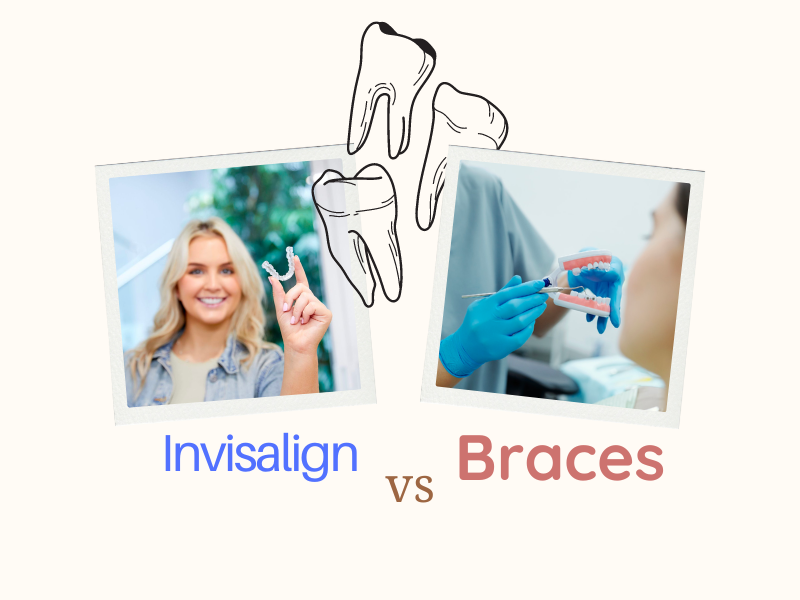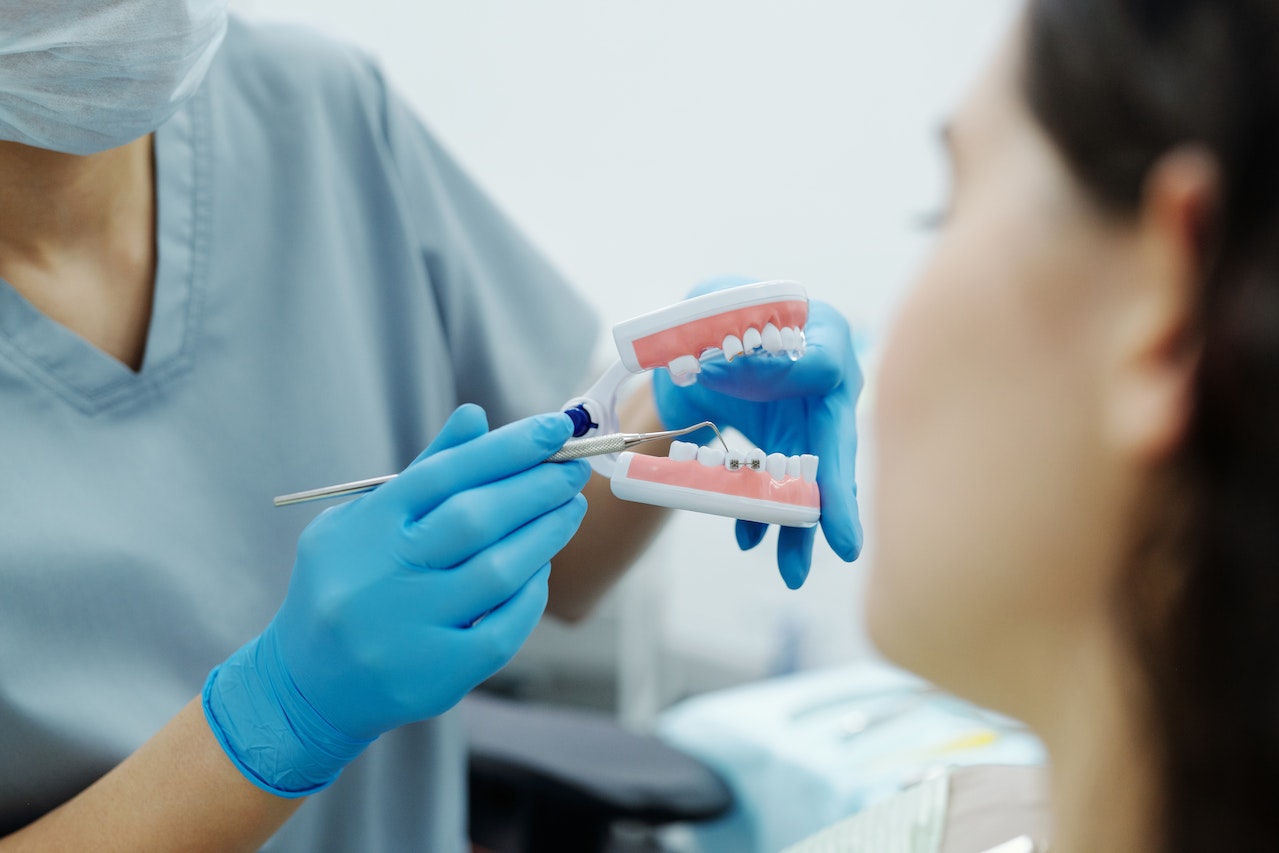Invisalign vs Braces – Pros & Cons to Help You Decide
Are you dissatisfied with your smile and looking for a way to straighten your teeth? Orthodontic treatment is the key to achieving a healthy and beautiful smile. But choosing between Invisalign or braces can be tough to decide if you’re not sure which treatment is right for you.
In this article, we’ll compare the pros and cons of Invisalign and braces, the two most popular orthodontic treatments available in Australia. From appearance to cost to treatment duration, we’ll cover everything you need to know to make an informed decision and achieve the smile of your dreams.
Invisalign Pros & Cons

Invisalign uses clear, removable aligners that fit over the teeth to gradually move them into position.
Invisalign Pros

Invisalign uses clear, removable aligners that fit over the teeth to gradually move them into position.
- Appearance
- Comfort
- Easily removable
- Fewer appointments
Let’s take a look at each of these pros in more detail…
Appearance
The clear, plastic material of the aligners is virtually invisible, providing a more aesthetically pleasing treatment option for many patients. Invisalign aligners can provide a more comfortable and discreet way to straighten teeth, without the visible metal wires or brackets of traditional braces.
As a result, patients can feel more confident and comfortable throughout the treatment process and achieve a beautiful smile without any aesthetic drawbacks.
Comfort
The clear, plastic aligners are custom-made to fit snugly over the teeth, minimising any discomfort or pain that can be caused by metal brackets or wires.
Invisalign aligners are smooth and do not have any sharp edges that can irritate the gums or cheeks. Therefore, patients can experience a more comfortable treatment process that doesn’t interfere with their daily activities or cause unnecessary pain or discomfort.
Easily removable
Unlike traditional braces, which are fixed to the teeth and require special tools for removal, Invisalign aligners can be taken out by the patient. This allows for more flexibility in eating and drinking, as there are no food restrictions.
Additionally, patients can brush and floss their teeth normally, maintaining better oral hygiene during the treatment process.
Fewer appointments
While traditional metal braces require frequent adjustments and tightening, Invisalign aligners are designed to be changed every few weeks at home. This means that patients typically require fewer appointments with the dentist or orthodontist throughout the treatment process, making it a more convenient option for many people.
Patients can often change their aligners at home and only need to come in for progress checks every few weeks, minimising any disruption to their daily routine.
Invisalign Cons

- Cost
- Discipline
- Effectiveness
Let’s take a closer look at some of the potential drawbacks of this treatment option…
Cost
In general, Invisalign treatment can be more expensive than traditional braces due to factors such as treatment duration, the complexity of the case, and location. Insurance coverage for Invisalign is also limited and patients may need to pay out of pocket for most or all of the treatment costs.
However, it’s important to remember that every case is different, and the cost of Invisalign can vary depending on individual circumstances.
Discipline
Unlike traditional braces, which are fixed to the teeth and cannot be removed by the patient, Invisalign aligners can be taken out. This means that the patient is responsible for wearing the aligners for at least 20 hours a day and replacing them every few weeks.
Failure to wear the aligners consistently can lead to slower progress and increased costs. This requires a higher level of discipline and responsibility on the part of the patient, which may not be suitable for everyone.
Effectiveness
Effectiveness can be a disadvantage of Invisalign treatment, particularly in cases of more severe dental issues that may require more significant movement for teeth alignment. Invisalign aligners may not be as effective as traditional braces for correcting complex dental problems such as significant bite issues or very crooked teeth.
In such cases, traditional braces may be a more effective option. It’s important to consult with a dentist or orthodontist to determine the best treatment option for you.
Braces Pros & Cons
Braces use metal wires and brackets, or sometimes headgear, to apply pressure to the teeth and move them.
Pros

- Effectiveness
- Customisation
- Affordability
- Reliability
Let’s take a look at each of these pros in more detail…
Effectiveness
Unlike Invisalign and other orthodontic treatments, metal braces are a proven and effective method for correcting a wide range of dental issues.
The brackets and wires of traditional braces provide the orthodontist with greater control over tooth movements, ensuring that teeth are shifted into the correct position for optimal dental health. As a result, patients can achieve a straighter, healthier smile and enjoy the long-term benefits.
Customisation
Metal braces offer a wide range of customisation options, such as coloured bands, to allow patients to personalise their treatment and express their personality. This can be especially appealing to children and teens, who may enjoy the opportunity to customise their braces with their favourite colour.
The aesthetic customisation options of metal braces can also help to alleviate some of the self-consciousness that patients may feel about wearing braces, making the treatment process a more positive and enjoyable experience.
Affordability
In general, metal braces are more affordable than other orthodontic treatment options, including Invisalign. This can make metal braces a more accessible option for patients who may not have the financial means to pursue more expensive treatments.
Many orthodontists offer payment plans and financing options to help make metal braces more affordable and accessible to a wider range of patients.
Reliability
Unlike clear Invisalign aligners, which can be lost or misplaced, traditional metal braces are securely fixed to the teeth throughout the entire treatment process.
This can be a significant advantage for patients who may struggle with the discipline required to wear Invisalign aligners as directed.
Cons

- Aesthetics
- Discomfort
- Maintenance
Let’s take a closer look at some of the potential drawbacks of this treatment option…
Aesthetics
The brackets and wires of metal braces are highly visible, which can impact a patient’s self-confidence and make them feel self-conscious about their appearance during the treatment process.
This can be especially concerning for adult patients who may feel that the appearance of metal braces is not suitable for their personal or professional life.
Discomfort
Metal braces can cause irritation or soreness in the mouth, especially during the first few days or after adjustments. Patients may also experience discomfort or pain when eating or speaking and may need to modify their diet or dental care routine to manage the discomfort.
However, the discomfort associated with metal braces is typically temporary and can be managed effectively with over-the-counter pain relievers or other remedies.
Maintenance
The brackets and wires of metal braces require regular maintenance, including adjustments, tightening, and cleaning. Patients may need to visit their orthodontist frequently to ensure that the braces are working effectively and to make any adjustments.
Oral hygiene can also be more challenging with metal braces, and patients may need to modify their brushing and flossing routine to maintain good dental health. However, with proper care and attention, patients can manage their maintenance requirements for optimal dental health.
Other Considerations for Braces vs Invisalign

When considering your orthodontic treatment options, there are a number of factors that patients should take into account beyond the pros and cons of Invisalign and braces.
The cost and length of the treatment, your age, your mouth bite, and your lifestyle are all important considerations that can impact the effectiveness and suitability of each option.
Let’s take a closer look at these factors…
Cost
The cost of orthodontic treatment can vary significantly depending on a number of factors, including the type of treatment, the complexity of the case, and the location of the orthodontist. In general, however, Invisalign tends to be more expensive than traditional metal braces.
The average cost of Invisalign treatment in Australia ranges from $6,000 to $9,000, while the cost of traditional metal braces typically ranges from $3,000 to $8,000.
It’s important to note that these are only rough estimates, and you should consult with your orthodontist to get a more accurate cost based on your individual needs and circumstances.
Age
In general, Invisalign is more suitable for adults and other teenagers with mild to moderate orthodontic issues, while traditional metal braces are often recommended for children and patients with more complex dental issues.
This is because metal braces provide greater control and are more effective at correcting severe dental issues, which may be more common in younger patients.
What’s more, children’s teeth and jaws are still developing, so early intervention with traditional metal braces can be essential for preventing more serious dental issues later in life.
Mouth Bite
Traditional metal braces are typically more effective at correcting more complex bite issues, such as overbites, underbites, and crossbites. In contrast, Invisalign is typically better suited for mild to moderate bite issues, such as minor crowding or spacing.
However, every patient is unique, and the best course of treatment will depend on the individual’s specific dental needs and circumstances.
An experienced Orthodontist can evaluate the patient’s bite and recommend the most appropriate treatment option to achieve the best possible results.
Length of Time
Invisalign treatment generally tends to be shorter than treatment with traditional metal braces, with an average treatment time of 6 to 18 months compared to 18 to 30 months for metal braces.
However, the length of treatment will depend on the complexity of the case, and some patients may require shorter or longer treatment times regardless of the type of treatment they choose.
It’s important for patients to discuss their treatment goals and expected timeline with their orthodontist to determine the best course of treatment for their individual needs.
Should I choose Invisalign or braces?
While Invisalign offers the advantage of being more discreet and comfortable, traditional metal braces provide greater control and can be more effective at correcting severe dental issues. Ultimately, the best course of treatment will depend on your dental needs and lifestyle.
You should consult with an experienced orthodontist to discuss your treatment options and determine the most effective and suitable treatment plan to achieve optimal dental health and a beautiful smile.
North Shore’s leading dentist
If you’re located in or near Sydney’s North Shore, then KB Village Dental is here to help you through any dental treatments. From a simple check-up and cleaning to an emergency visit, you’ll always get a warm welcome and comfortable experience from our expert dentists.
You don’t need to let fear or embarrassment about visiting a dentist interfere with your life. Contact us to find out how we can help you get your dental care back on track!


